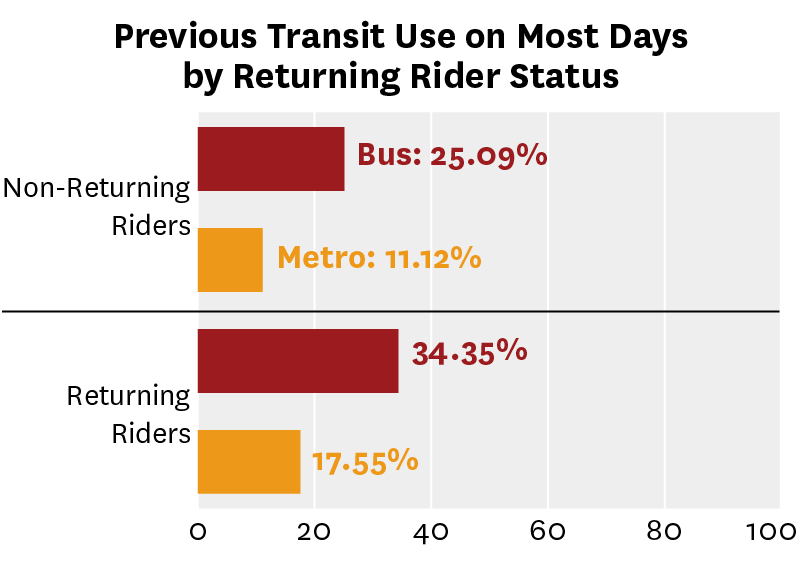The results of our 2024 LABarometer survey on Mobility & Sustainability are in and they reveal some mixed progress in current efforts to increase environmental sustainability and resilience to climate change in L.A. County.
Since 2019, our LABarometer surveys on mobility and sustainability have been fielded annually to a representative panel of adults living in households throughout L.A. County. This fourth wave of the survey was fielded to a total of 1,499 Angelenos from February 21 – April 21, 2024. The survey covered a wide range of topics, including heat and pollution exposure, pro-environmental behavior, climate change, transportation sentiment, and transportation access and behavior.
To explore how key outcomes from our Mobility & Sustainability survey have changed over time, we compared the results of our latest survey to results from prior surveys. Here are some key takeaways from our study.
1. L.A. homes are making gains in energy efficiency.
In a region increasingly exposed to extreme heat and pollution, we see an uptick in the number of residents with energy efficient homes and vehicles. Since 2020, an increasing number of residents have been equipping their homes with solar panels and energy-efficient landscaping as well as well-insulated windows and doors. Importantly, these rates are highest among high-income residents as well as Non-Hispanic White and Asian residents.

We also see a big uptick in rates of electric vehicle ownership in L.A. County – from 1.9% in 2020 to 7.3% in 2024. Again, rates of EV ownership are highest among high-income, non-Hispanic White, and Asian residents.

2. In other aspects of life, solar panel and electric vehicle owners are no more “sustainable” than non-owners.
We compared solar panel/electric vehicle owners to non-owners on an index of sustainable behaviors to better understand the degree to which solar panel and EV owners are exceptional in their willingness to live sustainably. The index measures the frequency with which survey respondents engage in 15 types of pro-environmental behavior, including recycling, composting, limiting car usage, limiting water usage, limiting electricity usage, limiting food waste, limiting consumption of meat, buying or eating locally grown or un-processed food, etc.
Interestingly, we observe no difference in the sustainability scores of owners versus non-owners, which means willingness to purchase solar panels and EV’s may be a stronger signal of financial capacity than environmental ideology. This also means solar panels and EV’s might be adopted by less economically advantaged Angelenos if there were stronger economic incentives to do so.

3. More Angelenos than ever are composting.
The recent implementation of organic waste pickup programs across the county may be linked to the small increase we see in the percentage of residents who are composting. According to our survey, nearly 20% of respondents compost often or very often – up from 15% in 2023 and 12% in 2020.

4. In the wake of the COVID-19 pandemic, public transit ridership remains depressed and car culture prevails.
Unfortunately, there is one area of life where residents remain resistant to change: their reliance on cars. According to our survey, 45% of L.A. County residents now rely solely on their car to get them places in L.A. – up from 33% in 2019.

Rates of public transit use also remain lower than pre-pandemic. In 2019, 35.1% of LA County residents reported using public transportation at least once in the last 12 months. By 2021, that percentage had dipped to 12.5%. Since then, public transit use has nearly doubled but still remains substantially lower than pre-pandemic levels, at 23.8%.

5. Who stopped using public transit? High-income residents, occasional riders, car owners.
About half of low-income residents (making <$30k) who rode public transit in 2019 are still using public transit in 2024 while only about a quarter of high-income residents (making $100k+) who rode public transit in 2019 are still using it.
Many of these former riders used public transit only occasionally. The graph below looks at the percentage of returning versus non-returning riders who used the bus or metro at a high frequency (“most days of the week”) in 2019. The graph shows that, among those who used public transit in 2019, non-returning riders – that is, people who no longer ride the bus or metro in 2024 – were lower frequency riders in 2019 than returning riders – people who still ride the bus or metro in 2024. For example, 25.1% of non-returning bus riders reported using the bus most of the week in 2019 compared to 34.4% of returning riders.

Returning riders and non-returning riders used public transit for different purposes as well. Returning riders were more likely to use public transit in 2019 for their work commute or personal errands. Non-returning riders, on the other hand, were more likely to use public transit to get to the airport or, in the case of the metro, for social or leisure activities. In other words, those who continue to ride public transit were more likely to rely on it for the necessities of daily life while those who stopped riding public transit were more casual users to begin with.
What is keeping so many Angelenos in their cars and off public transit? Our results – discussed in greater depth in our recent press release – suggest declining perceptions of safety and convenience may be a factor. Car ownership is also considerably higher among non-returning riders – 90% of non-returning riders owned a car when the pandemic hit in 2020 compared to 70% of returning riders.
Learn more
To learn more about mobility and sustainability issues in L.A., including how residents’ attitudes and behaviors have changed since 2019, check out our latest press release, tracking report, or visit our website.

You must be logged in to post a comment.